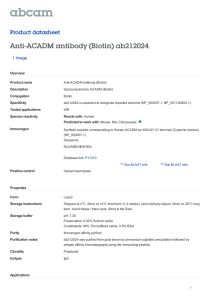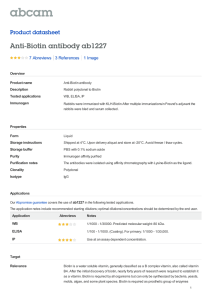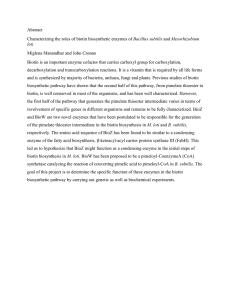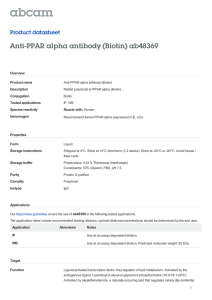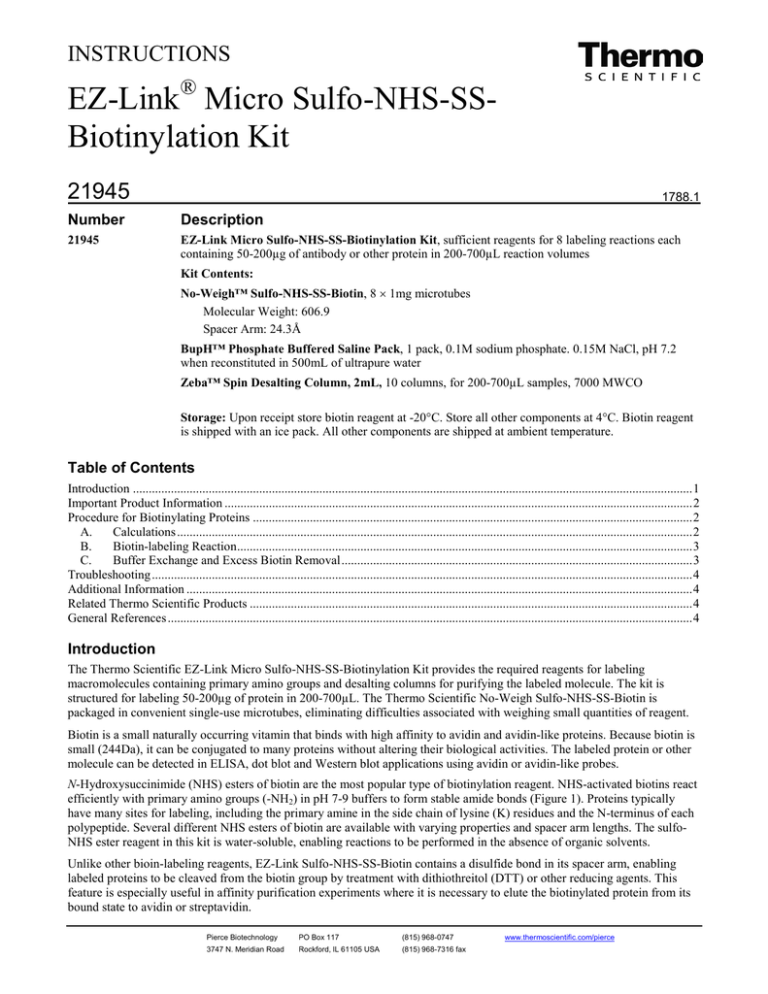
INSTRUCTIONS
EZ-Link® Micro Sulfo-NHS-SSBiotinylation Kit
21945
1788.1
Number
Description
21945
EZ-Link Micro Sulfo-NHS-SS-Biotinylation Kit, sufficient reagents for 8 labeling reactions each
containing 50-200µg of antibody or other protein in 200-700µL reaction volumes
Kit Contents:
No-Weigh™ Sulfo-NHS-SS-Biotin, 8 × 1mg microtubes
Molecular Weight: 606.9
Spacer Arm: 24.3Å
BupH™ Phosphate Buffered Saline Pack, 1 pack, 0.1M sodium phosphate. 0.15M NaCl, pH 7.2
when reconstituted in 500mL of ultrapure water
Zeba™ Spin Desalting Column, 2mL, 10 columns, for 200-700µL samples, 7000 MWCO
Storage: Upon receipt store biotin reagent at -20°C. Store all other components at 4°C. Biotin reagent
is shipped with an ice pack. All other components are shipped at ambient temperature.
Table of Contents
Introduction ................................................................................................................................................................................. 1
Important Product Information .................................................................................................................................................... 2
Procedure for Biotinylating Proteins ........................................................................................................................................... 2
A.
Calculations ................................................................................................................................................................... 2
B.
Biotin-labeling Reaction ................................................................................................................................................ 3
C.
Buffer Exchange and Excess Biotin Removal ............................................................................................................... 3
Troubleshooting ........................................................................................................................................................................... 4
Additional Information ................................................................................................................................................................ 4
Related Thermo Scientific Products ............................................................................................................................................ 4
General References ...................................................................................................................................................................... 4
Introduction
The Thermo Scientific EZ-Link Micro Sulfo-NHS-SS-Biotinylation Kit provides the required reagents for labeling
macromolecules containing primary amino groups and desalting columns for purifying the labeled molecule. The kit is
structured for labeling 50-200µg of protein in 200-700µL. The Thermo Scientific No-Weigh Sulfo-NHS-SS-Biotin is
packaged in convenient single-use microtubes, eliminating difficulties associated with weighing small quantities of reagent.
Biotin is a small naturally occurring vitamin that binds with high affinity to avidin and avidin-like proteins. Because biotin is
small (244Da), it can be conjugated to many proteins without altering their biological activities. The labeled protein or other
molecule can be detected in ELISA, dot blot and Western blot applications using avidin or avidin-like probes.
N-Hydroxysuccinimide (NHS) esters of biotin are the most popular type of biotinylation reagent. NHS-activated biotins react
efficiently with primary amino groups (-NH2) in pH 7-9 buffers to form stable amide bonds (Figure 1). Proteins typically
have many sites for labeling, including the primary amine in the side chain of lysine (K) residues and the N-terminus of each
polypeptide. Several different NHS esters of biotin are available with varying properties and spacer arm lengths. The sulfoNHS ester reagent in this kit is water-soluble, enabling reactions to be performed in the absence of organic solvents.
Unlike other bioin-labeling reagents, EZ-Link Sulfo-NHS-SS-Biotin contains a disulfide bond in its spacer arm, enabling
labeled proteins to be cleaved from the biotin group by treatment with dithiothreitol (DTT) or other reducing agents. This
feature is especially useful in affinity purification experiments where it is necessary to elute the biotinylated protein from its
bound state to avidin or streptavidin.
Pierce Biotechnology
PO Box 117
(815) 968-0747
3747 N. Meridian Road
Rockford, lL 61105 USA
(815) 968-7316 fax
www.thermoscientific.com/pierce
The EZ-Link Sulfo-NHS-SS-Biotinylation Kit combines the basic reagents, tools and easy-to-follow instructions for biotinlabeling amine-containing macromolecules. With this kit, even researchers who have never before labeled antibodies or other
proteins can expect to obtain results comparable to those obtained in commercial laboratories.
O
Na
O
O
S
O
O
N
O
O
O
S
S
HN
O
NH
N
H
S
Sulfo-NHS-SS-Biotin
O
O
Protein
Protein
Molecule with
Primary Amines
S
N
H
NH2
N
H
O
O
Na
S
HN
O
NH
S
Biotinylated Molecule
O S
O
N
OH
O
Sulfo-NHS Leaving Group
(later removed by gel filtration)
Figure 1. Reaction of Sulfo-NHS-SS-Biotin with primary amine. If drawn to scale, the oval representing the protein would
be many times larger than the reagent structures and would likely contain several amino groups. Note that Sulfo-NHS is a
leaving group (byproduct) in the reaction. The leaving group and any non-reacted biotin reagent are removed during the
desalting step.
Important Product Information
•
Use reconstituted Sulfo-NHS-SS-Biotin immediately. The NHS-ester moiety readily hydrolyzes and becomes nonreactive; therefore, do not prepare solutions for storage. Discard any unused reconstituted reagent.
•
Sulfo-NHS-SS-Biotin is moisture-sensitive. Immediately before use, puncture the microtube foil with a pipette tip, add
solvent and mix by pipetting up and down. After use, cut the used microtube from the unused microtubes and discard.
Store the microtube strip at -20ºC in the foil pouch provided.
•
Avoid buffers containing primary amines (e.g., Tris or glycine), as these will compete with the intended reaction (see
Figure 1). If necessary, dialyze or otherwise desalt to exchange the protein sample into an amine-free buffer such as
phosphate-buffered saline (one packet is included in this kit).
•
The desalting columns provided in this kit are best suited for processing biotinylation reactions involving 50-200µg of
protein in approximately 200-700µL. For smaller amounts of protein or smaller reaction volumes, perform both the
biotinylation reaction and buffer exchanges in a single Thermo Scientific Slide-A-Lyzer MINI Dialysis Unit (see
Additional Information and Related Thermo Scientific Products). For reaction volumes that are larger than can be
processed with a desalting column, split the sample between two columns or use an appropriate Slide-A-Lyzer® Dialysis
Cassette for buffer exchanges.
•
The biotin reagent is first prepared at ~5mg/mL before adding to the reaction mixture. To avoid having to pipette
volumes less than 1µL when biotinylating low protein amounts, dilute the biotin reagent further (e.g., 1:10 dilution). To
minimize hydrolysis in such a dilute solution, dissolve the biotin reagent in either anhydrous DMSO or DMF and make
dilutions with the same solvent.
Procedure for Biotinylating Proteins
A. Calculations
The extent of labeling depends on the size and distribution of amino groups on the protein, protein concentration and the
reagent amount used. Compared to reactions involving concentrated protein solutions, labeling reactions with dilute protein
solutions require a greater fold molar excess of biotin reagent to achieve the same incorporation level. Experiments that used
a 50-fold molar excess of biotin reagent to label 50-200µg of antibody (human IgG) for 30 minutes at room temperature
resulted in 1.5-5 biotin groups per antibody molecule. Adjust the molar ratio of Sulfo-NHS-SS-Biotin to protein to obtain the
level of incorporation desired.
Pierce Biotechnology
PO Box 117
(815) 968-0747
3747 N. Meridian Road
Rockford, lL 61105 USA
(815) 968-7316 fax
2
www.thermoscientific.com/pierce
1.
Calculate the millimoles of Sulfo-NHS-SS-Biotin to add to the reaction for a 50-fold molar excess:
mL protein ×
•
2.
mg protein mmol protein 50 mmol Biotin
×
×
= mmol Biotin
mmol protein
mg protein
mL protein
50 = Recommended molar fold excess of biotin per protein sample
Calculate microliters of 8 mM Sulfo-NHS-SS-Biotin (prepared in Step B.3) to add to the reaction:
mmol Biotin ×
200 μL
607 mg
×
= μL Biotin Solution
mmol Biotin 1 mg
•
607 = Molecular weight of Sulfo-NHS-SS-Biotin
•
200 = Microliters of solvent in which 1mg of Sulfo-NHS-SS-Biotin is dissolved to make 8mM
Example: To 0.7mL of 0.29mg/mL IgG (150,000 MW) ~8µL of 10mM Sulfo-NHS-SS-Biotin will be added.
0.7 mL IgG ×
50 mmol Biotin
1 mmol IgG
0.29 mg IgG
×
×
= 0.0000676 mmol Biotin
1 mmol IgG
150,000 mg IgG
1 mL IgG
0.0000676 mmol Biotin ×
200 μL
607 mg
×
= 8.2 μL Biotin Solution
mmol Biotin 1 mg
B. Biotin-labeling Reaction
1.
Dissolve 50-200µg of protein in 200-700µL of phosphate-buffered saline (PBS) according to the calculation made in
Section A. Prepare the Thermo Scientific BupH PBS as directed on the package label.
Note: Protein already dissolved in amine-free buffer at pH 7.2-8.0 may be used without buffer exchange. Proteins in Tris
or other amine-containing buffers must be exchanged into PBS. Perform buffer exchange of 200-700µL samples by
dialysis or using a desalting column included in this kit. This kit contains 10 single-use desalting columns and eight
microtubes of biotin reagent. Two columns may be used for buffer exchange, but the remaining eight columns are
needed to remove excess biotin reagent after performing the biotinylation reaction for each of the eight applications.
2.
Cut off one microtube of Sulfo-NHS-SS-Biotin from the No-Weigh Microtube Strip. Return the unused strip of
microtubes to its pouch and store desiccated at -20ºC.
3.
With a pipette tip, puncture the foil top on the biotin reagent microtube. Add 200µL of solvent and mix by pipetting up
and down to prepare an 8mM solution of Sulfo-NHS-SS-Biotin.
4.
Add the appropriate volume of Sulfo-NHS-SS-Biotin solution (see calculations in Section A) to the protein solution.
5.
Incubate the reaction on ice for two hours or at room temperature for 30-60 minutes. There is no harm in reacting longer
than the specified time other than the possibility of ordinary protein degradation or microbial growth.
Note: Although excess non-reacted and hydrolyzed biotin reagent remains in the solution, it is often possible to perform
preliminary tests of the labeled protein by ELISA or Western blot. Once function has been confirmed, buffer exchange
the labeled protein for optimal performance and stability using the procedure in Section C.
C. Buffer Exchange and Excess Biotin Removal
1.
Prepare a Zeba Spin Desalting Column by breaking off the bottom plug and placing the column into a 15mL collection
tube. Centrifuge the column at 1000 × g for 2 minutes, discard the storage buffer and return column to the same
collection tube. Place a mark on the side of the column where the compacted resin is slanted upward. Place column in
centrifuge with the mark facing outward in all subsequent centrifugation steps.
2.
Equilibrate the column by adding 1mL of PBS to the top of the resin bed and centrifuging at 1000 × g for 2 minutes.
Discard the flow-through and repeat this step 2-3 times.
3.
Place column into a new 15mL collection tube and apply protein sample directly onto the center of the resin bed. Allow
sample to absorb into the resin.
Note: For samples < 400µL, add 100µL ultrapure water stacker on top of the absorbed sample to maximize recovery.
Pierce Biotechnology
PO Box 117
(815) 968-0747
3747 N. Meridian Road
Rockford, lL 61105 USA
(815) 968-7316 fax
3
www.thermoscientific.com/pierce
4.
Centrifuge the column at 1000 × g for 2 minutes. The collected flow-through solution is the purified protein sample.
Store the protein solution in appropriate conditions.
Troubleshooting
Problem
Lack of biotinylation
Possible Cause
No amines available on molecule of
interest
Buffer contains primary amines
Protein is non-functional
Reagent not reactive caused by
hydrolysis of the NHS ester
Not enough biotin reagent was added to
the reaction mixture
Carrier protein was added to purified
IgG to help stabilize it
Excessive biotinylation
Low protein recovery after
desalting
No stacker used
Unstable protein
Low level of biotinylation
Solution
Use a biotinylation reagent that targets a different
functional group or convert sulfhydryl to amine
using Aminoethyl-8 (Product No. 23010)
Use a non-amine-containing buffer
Use reagent immediately upon reconstitution
Increase the molar excess of biotin reagent to
protein
Remove carrier protein before biotinylation to
reduce competition for labeling
Reduce the molar excess of biotinylation reagent,
or reduce time or temperature for biotinylation
Apply a stacker above sample
Equilibrate column in a suitable buffer
Additional Information
Please visit the web site for additional information including the following:
• Tech Tip #14: Perform labeling and other reactions in Slide-A-Lyzer Dialysis Cassettes
• Tech Tip #43: Protein stability and storage
Related Thermo Scientific Products
21925
EZ-Link Micro Sulfo-NHS-Biotinylation Kit
21326
No-Weigh Sulfo-NHS-Biotin, 8 × 1mg microtubes
21935
EZ-Link Micro Sulfo-NHS-LC-Biotinylation Kit
21327
No-Weigh Sulfo-NHS-LC-Biotin, 8 × 1mg microtubes
21445
EZ-Link Sulfo-NHS-SS-Biotinylation Kit
21328
No-Weigh Sulfo-NHS-SS-Biotin, 8 × 1mg microtubes
21955
EZ-Link Micro NHS-PEO4-Biotinylation Kit
21329
No-Weigh NHS-PEO4-Biotin, 8 × 2mg microtubes
20347
Streptavidin Agarose Resin, 2mL
66382
Slide-A-Lyzer Dilaysis Cassette Kit, 10K MWCO
General References
Ali, M.K. and Bergson, C. (2003). Elevated intracellular calcium triggers recruitment of the receptor cross-talk accessory protein calcyon to the plasma
membrane. J Biol Chem 278(51):51654-63.
Boroto, A., et al. (2003). Impaired trafficking and activation of tumor necrosis factor-alpha-converting enzyme in cell mutants defective in protein
ectodomain shedding. J Biol Chem 278(28):25933-9.
Chyung, J.H. and Selkoe, D.J. (2003). Inhibition of receptor-mediated endocytosis demonstrates generation of amyloid beta-protein at the cell surface. J Biol
Chem 278(51):51035-43.
Frickel, E-M., et al. (2002). TROSY-NMR reveals interaction between Erp57 and the tip of the calreticulin P-domain. PNAS 99(4):1954-9.
Li, H. and Pajor, A.M. (2003). Mutagenesis of the N-glycosylation site of hNaSi-1 reduces transport activity. Am J Physiol Cell Physiol 285:C1188-96.
Ohnishi, T., et al. (2003). MD-2 is necessary for the toll-like receptor 4 protein to undergo glycosylation essential for its translocation to the cell surface.
Clin Diagn Lab Immunol 10(3):405-10.
Pierce Biotechnology
PO Box 117
(815) 968-0747
3747 N. Meridian Road
Rockford, lL 61105 USA
(815) 968-7316 fax
4
www.thermoscientific.com/pierce
This product (“Product”) is warranted to operate or perform substantially in conformance with published Product specifications in effect at the time of sale,
as set forth in the Product documentation, specifications and/or accompanying package inserts (“Documentation”) and to be free from defects in material and
workmanship. Unless otherwise expressly authorized in writing, Products are supplied for research use only. No claim of suitability for use in applications
regulated by FDA is made. The warranty provided herein is valid only when used by properly trained individuals. Unless otherwise stated in the
Documentation, this warranty is limited to one year from date of shipment when the Product is subjected to normal, proper and intended usage. This
warranty does not extend to anyone other than the original purchaser of the Product (“Buyer”).
No other warranties, express or implied, are granted, including without limitation, implied warranties of merchantability, fitness for any particular
purpose, or non infringement. Buyer’s exclusive remedy for non-conforming Products during the warranty period is limited to replacement of or
refund for the non-conforming Product(s).
There is no obligation to replace Products as the result of (i) accident, disaster or event of force majeure, (ii) misuse, fault or negligence of or by Buyer, (iii)
use of the Products in a manner for which they were not designed, or (iv) improper storage and handling of the Products.
Current product instructions are available at www.thermoscientific.com/pierce. For a faxed copy, call 800-874-3723 or contact your local distributor.
© 2012 Thermo Fisher Scientific Inc. All rights reserved. Unless otherwise indicated, all trademarks are property of Thermo Fisher Scientific Inc. and its
subsidiaries. Printed in the USA.
Pierce Biotechnology
PO Box 117
(815) 968-0747
3747 N. Meridian Road
Rockford, lL 61105 USA
(815) 968-7316 fax
5
www.thermoscientific.com/pierce


